Search the Special Collections and Archives Portal
Search Results
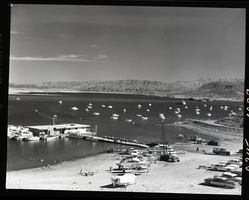
Film transparency of Las Vegas Bay, Lake Mead, Nevada, 1961
Date
1961
Archival Collection
Description
Boats are moored at the marina, as well as offshore. Some boats are on the beach, waiting to launch. A few small islands are visible in the background. Las Vegas Bay is a bay at the western edge of Lake Mead, to the northeast of the city of Henderson, Nevada, near the junction of Lake Mead Drive and Lake Mead Boulevard. A public campground and boat access are available in Las Vegas Bay. Low water levels of Lake Mead have rendered the marina there inoperable, and it relocated to the Hemenway Boat Harbor, in the south end of the Boulder Basin in 2002. The launch ramp there has also been closed due to the water levels. The Lake Mead Marina was relocated to the Hemenway Boat Harbor in 2008. The bay is the natural discharge point for the Las Vegas Wash. Las Vegas Wash is in the southeastern portion of the Las Vegas Valley and is approximately 12 miles long, from its headwaters northwest of Las Vegas to its mouth at Las Vegas Bay on the western portion of Lake Mead. The bridge across the Wash on Northshore Road is approximately 1.2 miles north of the intersection of Lakeshore and Northshore Roads.
Image
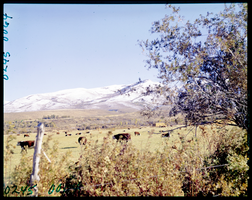
Film transparency of cattle grazing in a field, possibly in Lamoille Valley, Nevada, 1971
Date
1971
Archival Collection
Description
Cattle grazing in a field, possibly in Lamoille Valley, Nevada. Lamoille is located in Elko County, Nevada. It is located about 17 miles (27 km) east of Elko at the base of the Ruby Mountains at an elevation of 5,889 feet (1,795 m) and is part of the Elko Micropolitan Statistical Area. The early history of the community and surrounding area is summarized in a nearby highway marker. John Walker and Thomas Waterman first settled the area in 1865. Waterman named the valley after his native Vermont. In 1868, Walker erected the Cottonwood Hotel, store and blacksmith shop in the valley, and the settlement became known as "The Crossroads." Here wagons were repaired and food and supplies could be obtained. The original buildings and the more recent 20-bedroom Lamoille hotel, creamery, flour mill and dance hall are gone. Lamoille is nestled off the western flanks of the Ruby Mountains at the end of Nevada State Route 227, and is the principal gateway to this range via the National Forest Scenic Byway up Lamoille Canyon.
Image

Film transparency of the mountains near Virginia City, Nevada, circa 1940s
Date
1940 to 1949
Archival Collection
Description
The mountains near Virginia City, Nevada. Virga can be seen falling from the clouds. Like many cities and towns in Nevada, Virginia City was a mining boomtown; it developed virtually overnight as a result of miners rushing to the Comstock Lode silver strike of 1859 on the eastern slopes of Mount Davidson. But, Virginia City far surpassed all others for its peak of population, technological advancements developed there, and for providing the population base upon which Nevada qualified for statehood. The riches of the Comstock Lode inspired men to hunt for silver mines throughout Nevada and other parts of the American West. At its peak, Virginia City had a population of over 25,000 residents and was called the richest city in America. Dominated by San Francisco moneyed interests, Virginia City was heralded as the sophisticated interior partner of San Francisco. “San Francisco on the coast and Virginia City inland” became the mantra of west coast Victorian entrepreneurs. Early Virginia City settlers were in large part the backwash from San Francisco and the California Gold Rush, ten years before. Mine owners who made a killing in the Comstock mines spent most of their wealth in San Francisco.
Image
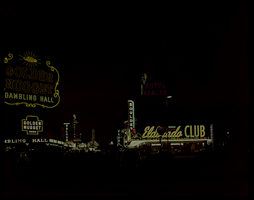
Film transparency of Fremont Street at night, Las Vegas, Nevada, July, 1949
Date
1949-05
Archival Collection
Description
Fremont Street at night. Visible on the left side of the street are neon signs for the Golden Nugget Gambling Hall, Nugget Saloon, Frontier Club, The White Spot Cafe, Pioneer Club, The Monte Carlo Club, The Union Pacific sign (in the background, right of center). Visible on the right side of the street are neon signs for the Vegas Club, Hotel Apache, and the Eldorado Club. The Golden Nugget opened in 1946, and is the first structure designed from the ground up to be a casino. Steve Wynn became the majority shareholder in 1973, and built the first tower in 1977. In 1984, the neon was removed from the building and the spa tower was built, along with the showroom. The third tower was opened in 1989. The hotel now has 2,419 rooms and suites. The casino's large hotel sign at its entrance off Fremont and Casino Center was removed in 1984 when the casino underwent renovations. The old sign presently sits at the YESCO (Young Electric Sign Company) sign yard.
Image
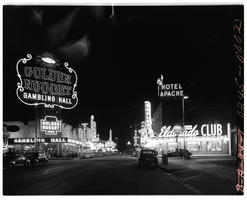
Film transparency of Fremont Street at night, Las Vegas, Nevada, July, 1949
Date
1949-05
Archival Collection
Description
Fremont Street at night. Visible on the left side of the street are neon signs for the Golden Nugget Gambling Hall, Nugget Saloon, Frontier Club, The White Spot Cafe, Pioneer Club, The Monte Carlo Club, The Union Pacific Railroad station sign (in the background, right of center). Visible on the right side of the street are neon signs for the Vegas Club, Hotel Apache, and the Eldorado Club. The Golden Nugget opened in 1946, and is the first structure designed from the ground up to be a casino. Steve Wynn became the majority shareholder in 1973, and built the first tower in 1977. In 1984, the neon was removed from the building and the spa tower was built, along with the showroom. The third tower was opened in 1989. The hotel now has 2,419 rooms and suites. The casino's large hotel sign at its entrance off Fremont and Casino Center was removed in 1984 when the casino underwent renovations. The old sign presently sits at the YESCO (Young Electric Sign Company) sign yard.
Image
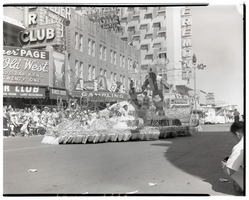
Film transparency of The Desert Inn Hotel's float entry in the Helldorado Parade, Fremont Street, Las Vegas, Nevada, May, 1958
Date
1958-05
Archival Collection
Description
The Desert Inn Hotel's float entry in the Helldorado Parade, Fremont Street, Las Vegas, Nevada, May, 1958. The float is titled "Aladdin's Wonderful Lamp," and features a couple dressed as Aladdin and Princess Jasmine with a large Genie behind them. Several children are seated around them. The float has just passed Joe W. Brown's Horseshoe Club (in operation from 1935-1958), located 128 Fremont Street at the corner of Fremont Street and 2nd Street, and is passing the Boulder Club, located at 118 Fremont street. The Boulder Club was in operation from 1931-1960. Part of a sign for "Farmer" Page that is on the Boulder Club is partially visible on the left. The Hotel Apache and the Fremont Hotel are visible in the background. A few people can be seen watching the parade from the windows of the Boulder Club and the Fremont Hotel.
Image
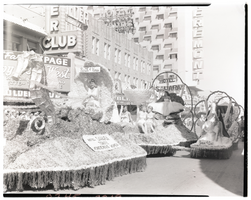
Film transparency of the Hotel Sahara float entry in the Helldorado Parade on Fremont Street, Las Vegas, Nevada, May, 1958
Date
1958-05
Archival Collection
Description
The Hotel Sahara float entry in the Helldorado Parade, May 1958. The float is titled "Hotel Sahara Toasts Wondrous Women." Smaller sections of the float are names "Birth of Venus" featuring a woman seated in a large clam shell that is being pulled by a large seahorse. The main portion of the float features three women seated beneath a large champagne glass, and a fourth woman seated on a large throne made of flowers. A side section of the float is titled "Joan of Arc," but the woman is obscured behind the horse sculpture she is riding. They are in front of the Boulder Club, located at 118 Fremont Street. The Boulder Club was in operation from 1931-1960. A sign on the Boulder Club reads ""Farmer" Page - Enjoy the Old West - Jackpots, Craps, Bar, Keno, Roulette, Twenty-One." They have just passed Joe W. Brown's Horseshoe Club (in operation from 1935-1958), located 128 Fremont Street at the corner of Fremont Street and 2nd Street. The Hotel Apache and the Fremont Casino are visible in the background.
Image
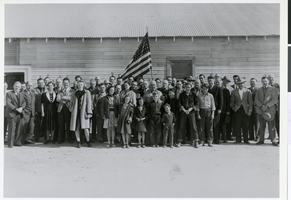
Photograph of the Kiwanis Club, Las Vegas, February 3, 1943
Date
1943-02-03
Archival Collection
Description
The Kiwanis Club of Las Vegas of which Ed Von Tobel, Sr. was a charter member. In the photo many old-time community leaders can be identified. Left to right: 1) Victor Shurtleff, 2) Fred Bartlett, 3) Mrs. Stella Fleming, Clark County Welfare director, 4) Ed Von Tobel, Sr., 5) Bert Purdy, 6) Herb Kraus, 7) V. Gray Gubler, 8) Monsignor Donald Carmody, 9) Dr. Hale B. Slavin, 10) David Farnsworth, 11) James H. Down, Sr., 12) Judge A.S. Henderson, 13) Robert B. Griffith, 14) The Rev. Ford L. Gilbert, Methodist Church pastor, 15) Otto Kimball, 16) I.R. "Cy" Crandall, and 17) George "Bud" Albright. Physical object has an insert containing additional biographical information.
Image
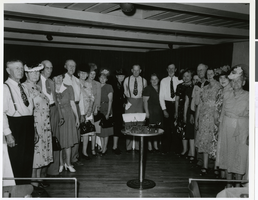
Photograph of the Las Vegas Chamber of Commerce luncheon, May 6, 1947
Date
1947-05-06
Archival Collection
Description
The May 6, 1947 Las Vegas Chamber of Commerce luncheon honoring the pioneers of Las Vegas. The luncheon was held at the Biltmore Hotel, corner of Bonanza Road and No. Main Street. Shown here left to right are: Bob Hall, Mrs. C.P. "Mom" Squires, C.P. "Pop" Squires, Mrs. Ed Von Tobel, Sr., Mrs. R.E. Lake, Sr., with her two daughters, Mrs. Anna Lake Bearden and Mrs. Alice Lake Gifford, Mrs. Minnie Westlake with her son, Otto Westlake, Mrs. Charles Aplin, Charles Aplin, Mrs. Pearl Lavavey Payne, Mrs. Bob Hall, Fred Pine, Mrs. Fred Pine, Mrs. Ann Kramer, and Mrs. Emily Ball. Physical object has an insert containing additional biographical information.
Image
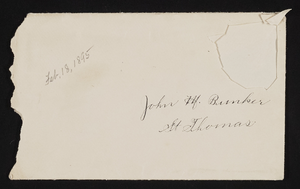
Letter and envelope from Mary M. Bunker, Bunkerville, Nevada to John M. Bunker, St. Thomas, Nevada
Date
1895-02-18
Archival Collection
Description
From the Syphus-Bunker Papers (MS-00169). The folder contains an original handwritten letter, a typed transcription of the same letter, the original envelope with the stamp removed, and a copy of the original letter.
Text
Pagination
Refine my results
Content Type
Creator or Contributor
Subject
Archival Collection
Digital Project
Resource Type
Year
Material Type
Place
Language
Records Classification
